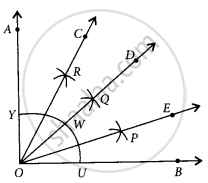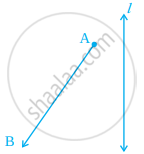Advertisements
Advertisements
प्रश्न
Bisect a right angle, using ruler and compasses. Measure each part. Bisect each of these parts. What will be the measure of each of these parts?
उत्तर

Steps of construction:
(i) Draw ∠AOB = 90° with the help of protractor.
(ii) Draw an arc with centre O and any radius, which cuts the ray OB and OA at U and Y.
(iii) With centres U and Y draw the arcs with radius more than `1/2 (hat(UY))`, which cuts each other at Q.
(iv) Join OQ and produce it to any point D as well as it cuts the arc `hat(YU)` at W.
(v) With centres U and W and radius more than `1/2 (hat(WU))` draw the arcs which cuts each other at P.
(vi) Join OP and produce it to any point E.
(vii) Now with centres Y and W and radius more than `1/2 (hat(YW))` draw the arcs which cuts each other at R.
(viii) Join OR and produce it to any point C. On measuring, we have ∠BOD = ∠AOD = 45° and ∠BOE = ∠EOD = ∠DOC = ∠COA = `22 1/2^circ`
APPEARS IN
संबंधित प्रश्न
Draw a line segment of given length and construct a perpendicular bisector to line segment using scale and compass
5.6 cm
Draw a line segment of given length and construct a perpendicular bisector to line segment using scale and compass
10.4 cm
It is possible to draw two bisectors of a given angle.
Infinitely many perpendiculars can be drawn to a given ray.
Draw the images of points A and B in line l of figure and name them as A’ and B’, respectively. Measure AB and A’B’. Are they equal?
Draw a line segment of length 7 cm. Draw its perpendicular bisector, using ruler and compasses.
Copy figure on your notebook and draw a perpendicular to l through P, using (i) set squares (ii) protractor (iii) ruler and compass. How many such perpendiculars are you able to draw?
Bisect a straight angle, using ruler and compasses. Measure each part.
Draw a line segment of length 6 cm. Construct its perpendicular bisector. Measure the two parts of theline segment.
Draw a circle with centre C and radius 3.4 cm. Draw any chord `overline"AB"`. Construct the perpendicular bisector of `overline"AB"` and examine if it passes through C.
